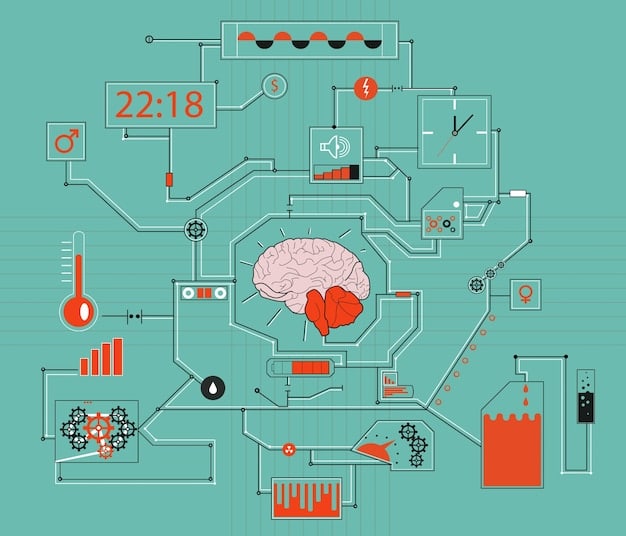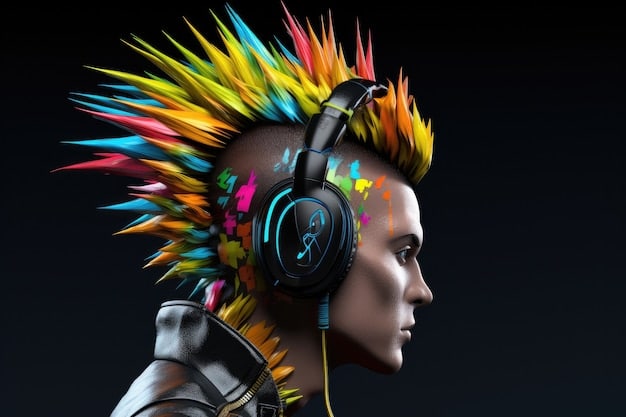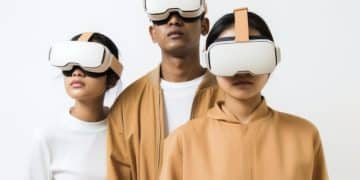Brain-Computer Interfaces: Revolutionizing Gen Z’s Learning and Creativity

Brain-computer interfaces (BCIs) are emerging as a transformative technology for Gen Z, offering unprecedented opportunities to enhance learning and creativity by directly connecting the human brain with digital systems, potentially revolutionizing education and artistic expression.
Exploring the potential of brain-computer interfaces for Gen Z’s learning and creativity reveals a future where technology merges seamlessly with the human mind. Imagine students mastering complex subjects with ease and artists creating masterpieces directly from their thoughts. This is the promise of BCIs, and it’s closer than you might think.
What are Brain-Computer Interfaces (BCIs)?
Brain-computer interfaces (BCIs) are systems that establish a direct communication pathway between the brain and an external device. This exciting technology can potentially revolutionize how we interact with machines and the world around us and is making waves when exploring the potential of brain-computer interfaces for Gen Z’s learning and creativity.
By decoding neural signals, BCIs allow users to control external devices with their thoughts, offering exciting possibilities in diverse fields such as healthcare, gaming, even education. But what exactly are the key components of these interfaces?
Key Components of BCIs
Understanding the building blocks of BCIs is essential. They typically consist of sensors to capture neural signals, signal processing algorithms to decode the data, and an output device that translates the decoded signals into actions.
The integration of these components enables BCI systems to interpret brain activity and provide a seamless user experience. Let’s break the components down further:
- Sensors: These detect brain activity, using methods like EEG (electroencephalography) or implanted electrodes.
- Signal Processing: Advanced algorithms decode neural signals, turning them into commands.
- Output Device: This could be a computer, robotic arm, or any device that responds to brain commands.

BCIs are becoming increasingly sophisticated, offering potential solutions and new ways to enhance human capabilities. As the technology evolves, its impact in specific fields will be more apparent.
BCIs in Education: A New Era of Learning
The application of BCIs in education opens a new horizon of possibilities for teaching and learning. By providing personalized educational experiences, BCIs may address individual learning needs and can explore the potential of brain-computer interfaces for Gen Z’s learning and creativity.
Can you imagine students learning complex concepts more rapidly and efficiently through direct neural feedback? BCIs promise improved focus and knowledge retention capabilities.
Personalized Learning Experiences
BCIs have the potential to revolutionize education by tailoring learning experiences to individual student needs. By monitoring brain activity, BCIs can identify areas where a student struggles, and provide targeted support.
This individualized approach can significantly improve learning outcomes and engagement. BCI can also:
- Provide real-time feedback on student comprehension and cognitive state.
- Adjust the difficulty level of educational content to match their abilities.
- Offer adaptive learning paths that cater to the student’s individual learning style.
BCIs can bridge the gap and help students who struggle with traditional methods. The future of education with BCIs is about creating a personalized and effective approach to learning.
Boosting Creativity with Brain-Computer Interfaces
Beyond improvements in education, BCIs also hold the potential to unlock new levels of creativity. Providing a direct pathway for translating thoughts into tangible creations, BCIs can improve the creative process in unique ways, significantly when exploring the potential of brain-computer interfaces for Gen Z’s learning and creativity.
Imagine artists being able to express their innermost visions with seamless ease, designing masterpieces and creating works that perfectly mirror their imagination.
Applications in Art and Design
In the realm of art and design, BCIs can serve as a powerful tool for artists and designers. By directly translating their thoughts and emotions into digital creations, BCIs allow the creation of art that is both deeply personal and technically advanced.
Artists can use BCIs to manipulate digital canvases, sculpt virtual objects, and create immersive experiences that were once impossible. With BCIs, they can:
- Allow artists to create art hands-free, using only their thoughts.
- Enable designers to prototype products directly from their mental models.
- Enhance collaborative creativity by sharing neural data between artists.

This leads to a more intimate connection with their work. The intersection of art and technology opens doors to uncharted possibilities.
Ethical Considerations and Challenges
The use of BCIs also raises key ethical and social questions. Addressing these concerns is crucial to ensure that this technology will be developed and integrated responsibly, particularly now that you are exploring the potential of brain-computer interfaces for Gen Z’s learning and creativity.
The privacy of brain data, the potential for misuse, and the need for regulation are just some of the issues that need to be addressed early on.
Privacy and Data Security
Brain data is incredibly sensitive. Protecting this information from misuse is paramount. Safeguarding your privacy must be a top priority when developing and deploying BCI technologies.
Robust security systems and data encryption protocols are essential to prevent unauthorized access and potential privacy breaches. But what else should be done?
- Implement strict data security measures to protect personal brain data.
- Establish clear guidelines on the collection, storage, and use of BCI data.
- Ensure transparency and user consent regarding data practices.
By addressing these ethical concerns, societies can ensure that BCIs are developed and used in a way that maximizes the potential benefits while minimizing the risks.
The Future of BCIs: Trends and Predictions
The future of BCIs looks incredibly promising, with continuous advances paving the way for new applications and improvements. These progressions can help while exploring the potential of brain-computer interfaces for Gen Z’s learning and creativity.
As technology continues to develop, BCIs will likely become more affordable, more accessible, and better integrated into various aspects of human life.
Advancements in BCI Technology
Advancements in BCI tech will shape the future. Researchers are constantly developing improvements in sensitivity, accuracy, and usability.
Non-invasive methods, such as EEG, are becoming more sophisticated, while invasive methods offer greater precision. Future advancements may include:
- Improvements in signal processing algorithms, resulting in more efficient data analysis.
- The development of wireless and wearable BCI devices, enhancing convenience and portability.
- The incorporation of artificial intelligence and machine learning to improve BCI performance.
Future BCIs will be more personalized, offering enhanced user experiences. As the technology evolves, the potential of BCIs will have a significant impact on a wide range of industries.
Gen Z’s Perspective on BCI Adoption
Gen Z’s embrace of new tech makes them prime candidates for early BCI adoption. This generation, known for tech-savviness, is open to innovations that enhance learning, creativity, and overall quality of life; this allows them to better explore the potential of brain-computer interfaces for Gen Z’s learning and creativity.
Understanding their attitudes and expectations is essential for successful assimilation of BCIs into their daily experiences.
Tech-Savviness and Openness to Innovation
Gen Z is highly receptive to modern technology, often embracing new tools and platforms that improve communication, enhance productivity, and promote creativity.
Their comfort with digital interfaces and their eagerness to explore innovative solutions make them the ideal user base for BCI technologies. Consider that they:
- Value personalized experiences and tailored solutions.
- Seek technologies that optimize their productivity and enhance their learning.
- Are enthusiastic about tech that boosts their creative expression.
Gen Z’s positive attitude and willingness to experiment with new technologies provide a fertile ground for wider integration of BCIs into various aspects of their lives.
| Key Aspect | Brief Description |
|---|---|
| 🧠 BCI Basics | Direct pathway between brain and external device. |
| 📚 Education | Personalized learning experiences and improved focus. |
| 🎨 Creativity | New levels of artistic expression via thought translation. |
| 🔒 Ethics | Privacy and responsible use of BCI technology. |
Frequently Asked Questions
▼
BCI systems typically involve sensors to record brain activity, signal processing algorithms to translate these signals, and an output device that performs the desired action based on the translated signals.
▼
BCIs can monitor brain activity to identify areas where students need support, providing personalized feedback and adaptive learning paths based on individual learning styles and comprehension levels.
▼
BCIs enable artists to directly translate their thoughts and emotions into digital creations, allowing them to manipulate virtual canvases, sculpt digital objects, and create immersive experiences hands-free.
▼
Key ethical concerns include privacy and data security, the potential for misuse of brain data, and the necessity for strict regulation and transparency to ensure BCI technologies are used responsibly.
▼
Future advancements include improved signal processing algorithms, the development of wireless and wearable BCI devices, and the incorporation of artificial intelligence and machine learning to enhance BCI performance and personalization.
Conclusion
As we’ve explored, brain-computer interfaces hold immense potential for revolutionizing Gen Z’s learning and creativity by directly linking the human brain to digital systems. Addressing the ethical and practical challenges is critical to harnessing the technology’s promise and ensuring that BCIs are implemented responsibly, paving the way for a future where learning and creativity are limitless.





